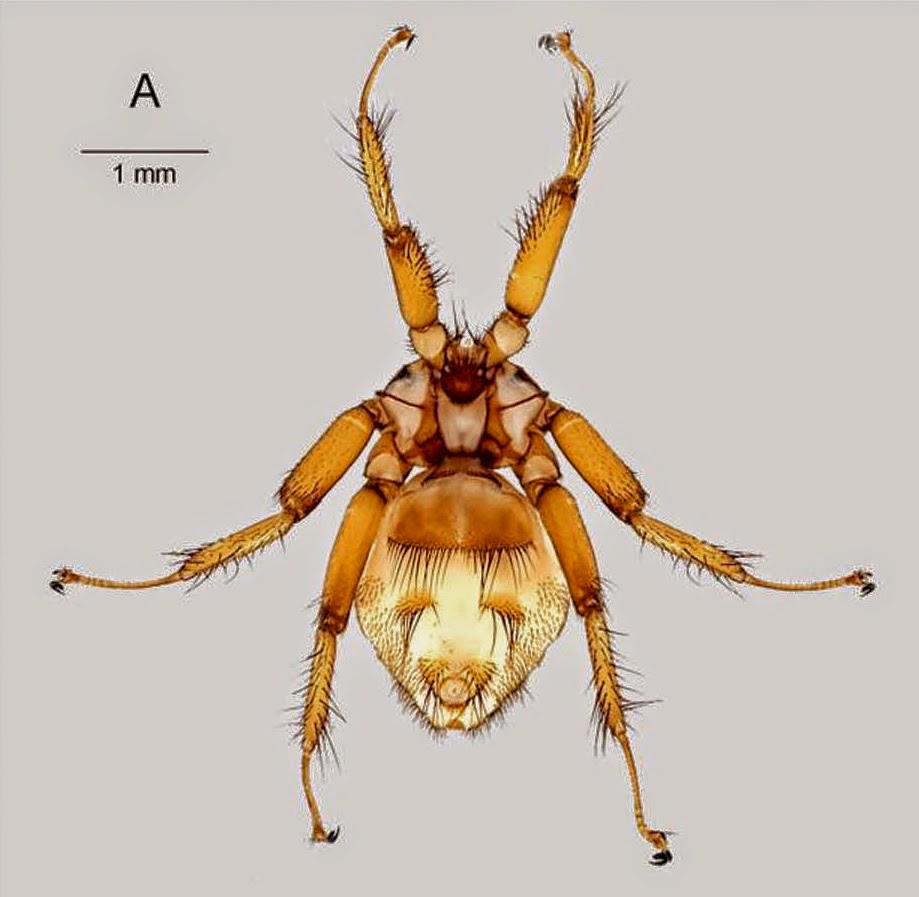Tachinids are a family of True Flies, Diptera, found across the
globe. They are noted for their parasitoid life-cycle, in which the larvae of
the Flies (maggots) grow inside the living body of a member of a host species,
typically another Arthropod, eventually killing the host. Unlike parasitic
Wasps, which typically can only infect a single host species, Tachinid Flies are
often able to target a range of host species. Tachinids have been found to
attack caterpillars (the larvae of Butterflies and Moths), including stem
mining species which are hard to access from the exterior of the plant, Sawfly
larvae, adult and larval Beetles, True Bugs, Orthopterans (Grasshoppers,
Crickets etc.) and even Centipedes.
In a paper published in the journal ZooKeys on 16 December 2014, Diego
Inclán of the Università degli Studi di Padova and the Sección Invertebrados at the Museo Ecuatorianode Ciencias Naturales and John Stireman of the Department of Biological Sciences
at Wright State University describe a new species of Tachinid Fly from Ecuador,
as part of a review of the genus Eucelatoria
in tropical Central and South America.
The new species is placed in the genus Eucelatoria and given the specific name flava, meaning ‘yellow’, in reference to the distinctive colour of
its abdomen. Eucelatoria flava is
described from two male specimens, both from the same locality, 7 km south of Baeza
in Napo Province, Ecuador, at an altitude of about 2000 m. These are 6.6-6.7 mm
in length, notably hairy and black in colour apart from the distinctive yellow
abdomen.
Specimen of Eucelatoria flava in
lateral view. Inclán &S tireman (2014).
See also…
 Parasitic Fly larvae from the Middle Jurassic of Inner Mongolia. A wide range of modern Insects survive as ectoparasites of
vertebrates, either by living permanently on their hosts, as with Fleas or by
visiting animals to feed, as with Mosquitoes. However identifying such
behaviour in the fossil record is difficult, and while a variety of parasitic
insects are known from Cainozoic deposits, only Fleas are known from the
Mesozoic, when...
Parasitic Fly larvae from the Middle Jurassic of Inner Mongolia. A wide range of modern Insects survive as ectoparasites of
vertebrates, either by living permanently on their hosts, as with Fleas or by
visiting animals to feed, as with Mosquitoes. However identifying such
behaviour in the fossil record is difficult, and while a variety of parasitic
insects are known from Cainozoic deposits, only Fleas are known from the
Mesozoic, when... Nycteribiid Bat Flies from the southwest Indian Ocean. Nycteribiid Bat Flies are True Flies, Diptera, that have lost their
wings and adopted a lifestyle as ectoparasites of Bats. They have an unusual
lifestyle, with the larva maturing within the female Fly (which only produces
one larva at a time), then being ‘laid’ during the pupa stage. The female Fly
leaves her host Bat to lay this pupa, which hatches 3-4 weeks later, producing
a new adult...
Nycteribiid Bat Flies from the southwest Indian Ocean. Nycteribiid Bat Flies are True Flies, Diptera, that have lost their
wings and adopted a lifestyle as ectoparasites of Bats. They have an unusual
lifestyle, with the larva maturing within the female Fly (which only produces
one larva at a time), then being ‘laid’ during the pupa stage. The female Fly
leaves her host Bat to lay this pupa, which hatches 3-4 weeks later, producing
a new adult... A new species of Fungus Gnat from the giant Sequoia groves of the Sierra Nevada Mountains, California.
A new species of Fungus Gnat from the giant Sequoia groves of the Sierra Nevada Mountains, California.
Follow Sciency Thoughts on Facebook.

